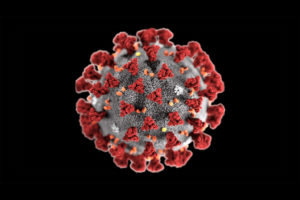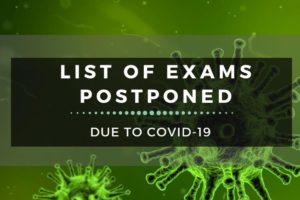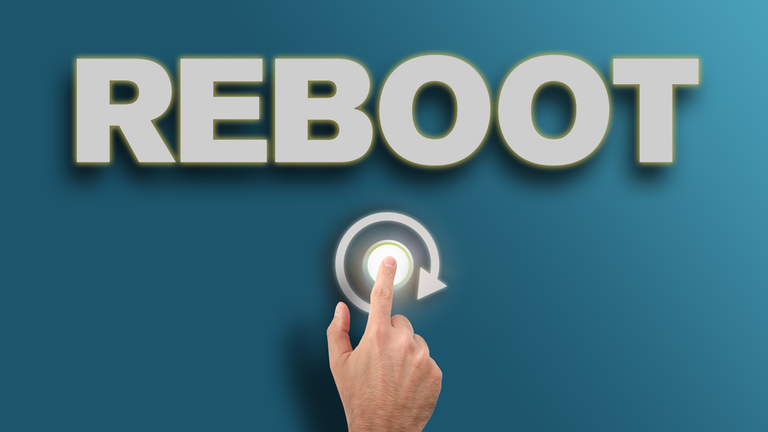
Health is a basic fundamental right of all citizens and health promotion forms an important and intrinsic part of healthcare. There is always a great degree of discrepancy between attitudes towards health and priorities. Even the countries which have social security assurance are going through the crisis of COVID -19, with great difficulty and unable to manage. We have witnessed this situation not only in Europe but even in the US. The infection has crossed 7million with mortality of nearly half a million.
As a researcher of management, I am exploring the possibilities of economies reopening and the change management required by a nation and individuals. This research covers socioeconomic, socio-tech, mental health and mindset changes required adapting to the new normal after the pandemic. The study carried out was cross-sectional and descriptive in nature. The study of the population which is limited to online education included students from varied backgrounds and professionals from linked in again from different industries. The researcher also had discussions with the professional post the survey responses. Descriptive research on various sectors of the economy is also part of the paper under the heading “The 7 spoke model of Rebooting the Wheel”
The world is now slowly coming to terms with a new normal with lots of ambiguity and uncertainties. This is one of the rarest opportunities in this century to respond with empathy and guide be it a business or life for that matter. This is the time we will witness the emergence of new thoughts, a new style of leadership and newer business models, a touchless technology and behave cohesively keeping the required distance socially. This is the period which will also to reflect upon why the think tanks of the world and leadership did not have a clue as to how to manage this kind of crisis effectively?
Where are the Harvard and Stanford thinkers who could not predict? It is indeed a tough ask and task as to how this pandemic has brought the whole world on its knees and trying to save the breath for a better future. Survive, Live and then rebuild the business. While the phrase of trace, test and treat is the mantra of Europe, many other countries are not able to address the basic issues of health and unable to manage lively hood resulting in riots and looting for food and migrant labours in agony economically deprived of almost the right to live. It has become a question of survival. Business houses are shut, countries are shut and lockdown and extensions prevailing across the world. We are witnessing crippling economies mounting mortality, vaccine news, hunger, poverty, migrant population unable to make both the ends to meet. The next pandemic will be of unemployment staring at us. Therefore, gradual rebooting of economic activity is bound to happen which needs to be managed with effective controls and social distancing by individuals.

Rebooting at this juncture needs combined world mental energy to help each other as nations and reduce geographical conflicts and differences for the sake of humanity. The business and political leadership should focus on rebooting strategy and contingency plans for the future to avoid this kind of helplessness. World’s largest economies are exposed to a situation of catastrophic mismanagement. Rebooting exercise must cover not only economic packages, support and interest rate adjustment, inflation management, credit availability, waiver or deferral of loans. It has to address employee safety, wellbeing, employee engagement and technology support to adapt to a newer way of rebuilding business be it digital, or online are a blend of various activities which can slowly. Supply Chains across sectors have to reboot, service pending orders if they are not cancelled, manage working capital by better cash management and reducing obsolete stocks and inventories piled up. Following Wheel will reflect the areas to reboot business and economy.
The summary of this research article is depicted in a diagram as under.
The 7 spoke Model of Economic Reboot (CNN’s 7 Spoke Model for Reboot)
Financial Reporting & Restructuring (FRR)
The world is now moving from a general economic downturn to specific sector-wise issues. It is beyond normal volatility of market conditions the magnitude and the time period is abnormally high. Therefore, normal predictable models will not work at least for two years from post corona era. Rebooting will take longer than a normal recession. The restructuring will happen in the portfolios of organizations. Even the IFRS reporting will undergo a change for reporting and certain provisions related to debtors and creditors. As there will be a broader economic downturn, there will be a prolonged negative impact.
Therefore, there will be more conservative and cautious reporting on revenues (topline predictions) and even the bottom line for that matter. In some of the countries CARES Act is also applicable while reporting. That is Coronavirus Aid, Relief and Economic Security Act. Finance Leaders and policymaker must clearly focus on new unpredictable environment existing globally. This may have an impact on even exports. The cash flow implications and working capital management are the biggest challenges for Finance Leaders until there are a steady flow and stability in Supply Chain. Navigating cautiously while steering the ship safely in turbulent times is the role of new finance leaders. It is not only volatility but a distressing time for everyone in the industry.
Consumer Spending & Portfolio Reshuffle (CSPR)
It is first, of all, expected to hit the consumer spending overall. Spends will come down as a result of a dip in the earnings. The priority spends will have more healthcare products, medical insurance, sanitizers, hand rub liquids, personal protection equipment, hygiene products. Huge drop can be witnessed in-mall shopping, theatres, travel and tourism and even the hotel industry. Branded spending may drop and convenience door delivery e-commerce will gain in this process. Huge drop in petrol and gasoline consumption due to lesser travel which includes restricted movements even in local areas.
Disruptions are likely to lead to a recession across sectors while organizations are confronted with systemic challenges and internal realignment of strategies, markets, supply chain, employee engagement, and better resource utilization. Simply a change management process to address the virtual and a real world. Changes in terms of product and portfolios, customer engagement and retention, servicing the customer orders, supply chain new models and incase of manufacturing it is simply managing the working capital and cash flow while ramping up the line for better utilization of the capacity which is finally connected rekindling and creating the demand for product and services when the deferrals are happening due to major economic breakdown and unemployment. Necessity is the mother of invention, that is what the business people have to do at this hour as to how to reach the customer remotely and recreate the demand for the products and services. There is no doubt it is all about the next chapter of Digital maturity at the time of disruption and distress in the market place.
Digital maturity and Transformation (DMT)
Digitally matured organizations will reap a bounty of benefits apart from topline growth. It may result in improved product quality, ability to negotiate better on prices of procurement, parts and sourcing and finally customer satisfaction. It may have other indirect benefits like environmental. The best example is digital payment during COVID19 times has resulted in containing the spread of virus avoiding currency exchanges and possible infections. To derive the edge of digital transformation organizations should do far more than simply implementing technologies. It requires coordinated efforts to link technological capability with the assets you are going to create and revenues you are going to generate or the savings you are going to accrue bringing a specific technology tool, AI or any other online processes which reduces labour, time and creation of convenience to consumers.
Digital platforms have to be secure and must address all security and privacy issues apart from the ability to flex capacity according to business and market demand. Now, Digital transformation must involve external partners, incubation centres, R&D and even startups to gain access to all sorts of resources to tap all possible markets and business through partnership MOUs. It is also critical to look at recalibrating processes and workflows to improve so that better value resources can be used better higher value. While making these changes in an organization customer-centric approach should be taken into account by all the stakeholders and vertical leadership so that a high degree of value creation is presented to customers. Last but not the least, digital transformation must address an array of business models and revenue streams which is nothing but the flexibility to the extent of different business model adaptability in times of need like COVID19 situation. Financial performance of organizations in future will be mainly dependent on digital transformation. We must also have a clear understanding of what can be digitized and can be online. It is industry-specific. If we take an example of the construction industry, presale and launching process, promotions, enquiry and registration can be digitized along with payment gateways for transfers of money. But the construction activity largely happens with the deployment of equipment and workmen which may involve manual skills. However, the Internet of things can be used for tracking progress and safety measures. The concept of work from home may not be applicable to skilled labour. On the contrary work from home may be much easier for IT organizations as compared to manufacturing lines. Similarly, education can perform certain things through online mode but certain things have to be in a laboratory or classroom setup. So, the extent of digitization is also dependent on the business and sectors.
Socio-Technological Changes (STC)
The dynamics of the environment will drive the business and services to a greater change process during and after a pandemic. Organizations and institutions must look at long term sustainability by working simultaneously on tactics and strategies. Managing economic cycles, competitive compulsions due to innovative methods of supply chain and consumer satisfaction will result in some unorthodox business models. Geopolitics and pressures and local regulatory framework will result in further stress on the management. There has to be a balance between these elements during a pandemic like this.
This will also set in new trends. Some state governments have taken charge of hostels of colleges for quarantine patients under the guise of addressing the issues for the larger public. But the fact is, these institutions that are forced to give the facility may have to face the wrath of employees working in the facility due to possible risk of infection spreading to the employees if they need to work closer to that facility. It is more of political will in the interest of students and academics to locate such centres in the outskirts like stadium or Bus terminals etc., instead of occupying hostels where the zones are green. In such cases, rebooting the institution for admission and other matters after 2 months lockdown will result in huge problems. However, these institutions have to deal with the risk effectively by balancing both employee safety and local politics.
Human Resource Care (HRC)
The most critical part of managing the pandemic is taking care of human resources during the time of distress. How to keep them motivated is secondary to maintaining mental health. Anxiety and stress are expected to soar due to the fear factor of virus and then insecurity of job at workplace and sustainability in the long run. Organizations have to show empathy first and then respond before recovering and thriving. A concurrence in consideration of all these will lead to better employee morale. Resilient leaders emerge in the crucible of crisis and they will be able to handle multiple priorities even during pandemic period one like Corona times. Leaders normally prepare the resources to manage continuity. Good leadership understands the mindset shift and then navigates the uncertainties and implications for business. They also script the recovery book during the journey and ensure the preproduction process is carried out seamlessly. Leaders drive team and facilitate through stakeholders and guide the business from responding to thriving. Building trust is critical so that unknown paths which are generally, physical, feelings, emotions, financial and finally digital too. Leaders need to understand shift the mindset towards designing the ways to publish the recovery book which is nothing but the organizational destination both in the short and long runs. Therefore, it is a journey with the team where the leaders need to make choices.
Another strategy adopted by great leaders during crisis time is to learn from the success of others when the team travels unchartered territory. HR leaders need to focus on mobility factors in terms of new policies for crisis period, workforce strategies which include managing the disrupted work environment for a longer period to pandemic spread of infections. Providing timely guidance and perpetual engagements with employees is critical. While statutory compliance is a minimal expectation from employees, organizations should also pay the salaries and wages on time. Even Rewards and Recognition (R&R) can be increased for better productivity working from homes. HR leaders must design, deliver and communicate enhanced reward program during the crisis not only for better productivity but also for retention and loyalty. HR leadership must renew contracts; negotiate with outsourced vendors for reduction of cost in the absence of services due to lockdown issues. Finally, they need to ensure more flexible and safe working arrangements. Another issue which needs to be addressed due to longer lockdown gestation is mental health. The continuous access to technology platforms, online is leading to a rise of Attention Deficit Hyperactivity Disorder (ADHD). This normally prevails in young generation due to an overload of gadget and technology use is now spreading to adults and middle-aged people also. It is a chronic condition marked by persistent inattention, hyperactivity, and sometimes impulsivity which ultimately leads to Anxiety-driven ADHD. It is a correlational pattern due to excessive usage of Technology, internet, consumer electronics, TV news channels, and mobile access. A judicious need-based usage will help to overcome ADHD. Another way to reduce the impact is to turn towards nature, physical fitness, music and art.
Combating COVID Disruptions (CCD)
There is no escape route from disruptions to any business. A few sectors related to health care and pharma and personal protection equipment may grow. But when the whole economy is in dismay the ripple effect will have an impact even on these organizations in managing crisis while they are operating as essential services with high risk. Sectors like aerospace, transportation, tourism, automotive; oil and gas industries will bear the brunt. But the interplay between personal safety and economic concerns will restrict customer spending on non-essential items. Groceries and food retailers will need to service unprecedented demand which will strain the entire system in the absence of channels not operating. Social media will play a vital role in combating disruptions during this type of crisis. Labour shortages will continue even if the rebooting happens and there is a marginal chance of running the business or production line in full scale.
There will be sustained category changes and permanent shifts in consumer behaviour due to the pattern of behavioural changes in the minds of consumers. Keeping the Distribution channel intact is very important. There will be more and more M&A’s when the rebooting failures are reflected in the system. If the economy is FDI friendly, then combating and sustaining this disruption will end in mergers and acquisitions. It is, therefore, necessary to focus on the mapping customer base in order of priority, open channels of communication with key accounts and monitor financial health and recovery of commercial stocks if necessary unpaid or liquidate obsolete even if it is at a deep discount.
Online Boom & Education are at Crossroads (OBEC)
As an integral part of the fabric of any society, reimagining higher education is a must for growing economies. India with a demographic edge of a young population at least for the next decade will experiment with various modes of higher education delivery. New models of education are emerging during the pandemic. The lockdown across the world triggered an online craze. Universities and colleges are now trying various modes of delivery through online ranging from Zoom platforms, Google Meets, Webinars, Microsoft platforms, Facebook Live. A sudden surge in internet bandwidth usage due to working from home has affected the quality of these online video-based classes. Many institutions which were struggling to regain business in online platforms and distance mode started promoting including branded online like Harvard and MITs of the world. There is a huge rush for certificate courses with a deep discount. As an educational practitioner, I doubt whether the actual effective learning curve is moving or creating loads of certificates for individual branding. How can we learn how the dynamics in higher education are transforming the role of a Vice-Chancellor or a Director? My view is there will be a considerable shift towards BLENDED LEARNING rather than a big shift towards online.
Online education can be an option when the universities and colleges are able to address the issues of quality content, easy access, electronic discussion boards, online discussion forums, quality evaluation methods and frequent and accurate assessment tools. It is also critical to understand the perspective of students (Learners) and Faculty members who deliver online classes. A simple survey of both freshers who are learners and professionals who are opting for online portal learnings reflected interesting insights on higher education. As a researcher, my findings echoed the following points to be pondered in higher education before concluding anything on the online shift. A survey of working executives with 4 to 10 years of experience reflected different results compared to freshers. In fact, the result of findings with students reflects that we are yet to mature to receive online platforms and contents and tools have to drastically improve to deliver quality online teaching. The sample of the survey covered students across colleges and managers across domains in different organizations. Findings are reflected in the form of pie diagrams which are self -explanatory in nature.
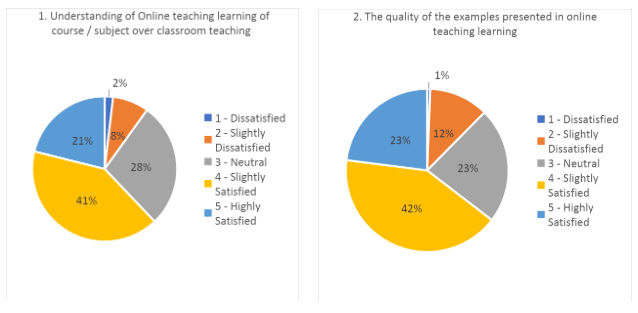
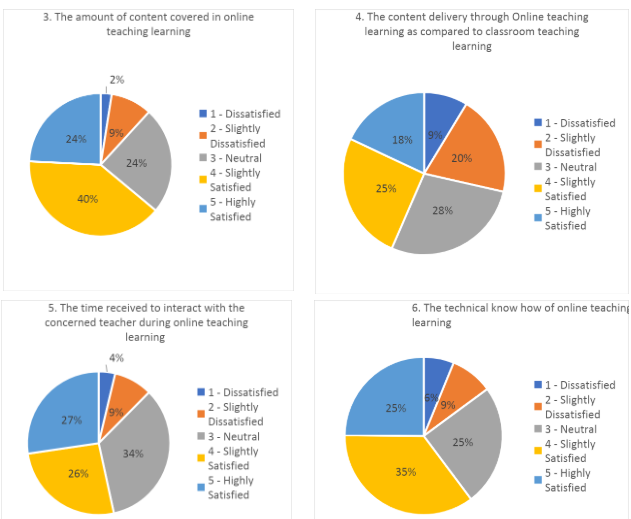
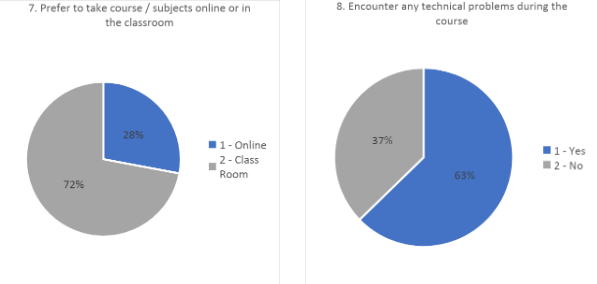
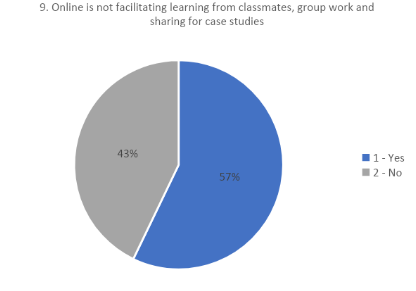
Conclusion on online education to students (Postgraduate Students)
- The Highly satisfied percentage is only 21% of the sample indicating maturity level is very low for online education in India.
- Developing quality content and example should be the focus of educators if the online has to grow. Only 40% are satisfied with the contents
- Nearly 30% of the sample reflected dissatisfaction on the Delivery.
- Majority of the respondents expressed the need for more time for discussions with the faculty to understand.
- Technology and bandwidth issues are major hurdles of online delivery
- 72% of the respondents prefer physical classrooms for teaching and learning process.
In India, though the online wave was flashing during the COVID-19 through various platforms like Zoom, Google Classrooms, Microsoft classrooms and even FB live, students prefer classroom experience due to combined learning process which may be absent in online teaching. The Indian student community has just entered the curve of Online. It may take several years to give the experience of the classroom. However, as a Researcher, I see a future of Blended Learning ,especially in management Education.
Online Education Survey of Working Executives (through LinkedIn)
The results of the online education preference amongst experienced professionals reflected a better degree of maturity for online education especially in the age group of 30-45 segments. The prime drivers for this were of Time, Convenience and cost. Many of the respondents were opting for online certification to improve their opportunities for promotion rather than knowledge seeking. Skill training is preferred in this category of respondents. The survey had divergence on the preference according to the age group. There is a strong correlation between the age and preference to online education. Majority of the respondents were towards BLENDED LEARNING in the higher education field. This is almost similar between all the age groups of respondents. There is a major correlation between the age group and the acceptance of online education. Lower age group segments in working executives showed more acceptances compared to the next two segments.
Strategies for change management in Indian Education Sector
- Understand and work out a new strategy for blended learning. Academic administrators must clearly understand to what extent online teaching can be done and what is the threshold limit for absorption by the students. Everything cannot be handled through online platforms especially for students who are freshers. Therefore, research to Indian context will help to arrive at a ratio of online to be applied and what can be through online what can be in small batches of classroom teaching, case study discussions and practical labs in case of science and engineering streams.
- Understand and address the issue of social quotient which will be missing in the online world- that is peer learning and sharing in a classroom environment.
- Have a clear understanding of value-based education system normally referred to as Eastern thoughts
- The management learning process to give an orientation towards the environment for long-run sustainability and development.
- Last but not the least, the pandemic also taught a lesson as to how to run successful startup models in distress time. Means, newer way of doing business and innovative supply chain models. Entrepreneurship focus should be carried forward to grow. These latest trends will emerge from the higher education sector when the market is experimenting with new models during the pandemic.
Conclusion: The results showed that economies around the world will take a minimum of three long years to come to a reconciliation with the pandemic losses. Rebooting will happen in a phased manner across countries. The rebooting in India across states will be in different phases and at a different pace. India will face a skilled labour issue until the migrant labour return to respective states of employment. The world will witness a change in business models, realignment of organizational goals. Individuals will be focusing on mental health to recover from pandemic losses both economically and mentally. It is also to be noted that there will be some sectors like technology, personal healthcare, mental health industry, pharmaceutical industry, and personal protective equipment industry, online education, online entertainment which will show promising growth. However, the overall economy will continue with the recession for a couple of years to recover after rebooting. Online education which witnessed huge growth and faster shift will finally settle in Blended Learning model. Educators and Educational administrators need to address this issue on Priority. There will be a huge change in consumer behaviour and the pattern of buying. The Digital world will continue to expand and grow and the future of organizations depends on the speed at which they shift to digital world. However, enough care has to be taken about mental health avoiding symptoms of anxiety and Hyperactivity disorders. Economies can bounce back to activities through a reboot and gradual movement towards the new normal if we take care of the components discussed in this article.

About the Author:
Dr. C.N.Narayana
Senior Professor & Director PCET’s Pune Business School
Author, Writer and Social Worker.


